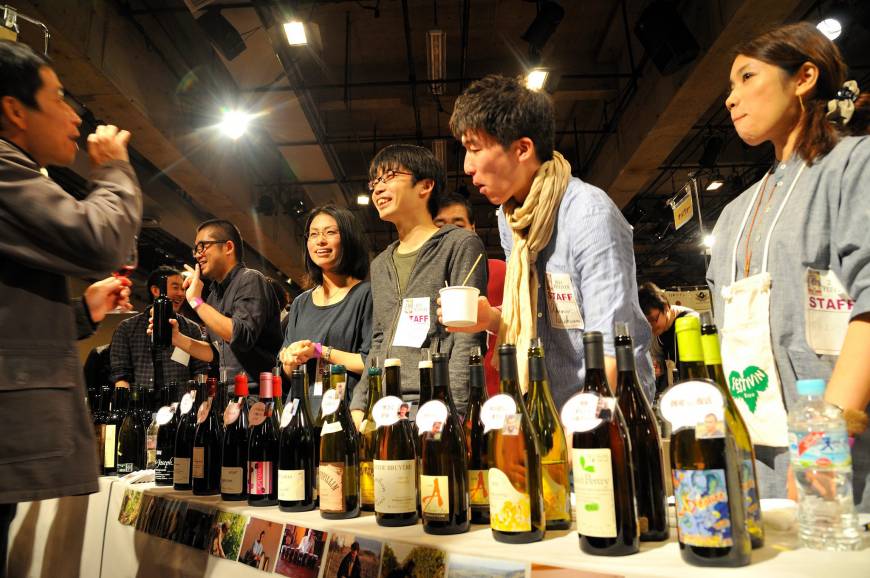
by Melinda Joe
Special To The Japan Times
In the four years since it started, Festivin has grown from an intimate gathering of natural wine enthusiasts to one of the most eagerly anticipated wine celebrations in Japan.
Like many avant-garde movements in the food and beverage world, the idea for Festivin began at a party, when Shinsaku Katsuyama, one of the early pioneers in the Japanese natural wine scene and owner of wine bar Shonzui in the capital’s Roppongi district, suggested that a group of importers, shop owners and journalists join forces to host a natural wine event. Approximately 2,200 people attended the third edition of Festivin in 2012, more than double the attendance of the first event, and the turnout is expected to rise when the fair returns to Tokyo on Nov. 30 for its fourth edition.
Part of what attracts so many people to the event is the fact that there’s something new to look forward to every time. Along with food and musical performances, Festivin 2014 will feature more than 300 natural wines from producers in Japan and around the world. This year’s lineup includes eight winemakers from the former Soviet republic of Georgia, who will be pouring a selection of unique wines fermented in large, egg-shaped clay vessels called kvevri.
Talisman of hard-core natural wine lovers (and boon to Scrabble players), the kvevri has been at the heart of wine-making in Georgia for thousands of years. Georgia is reputed to be the birthplace of Vitis vinifera, the varieties of grapes that are used to produce wine, and families have traditionally fermented wine at home in the clay jars, which were sometimes planted in the ground directly in the middle of the vineyards or set into the floor of the wine cellar. Under Soviet rule during the 20th century, however, regulations mandating high-volume production wiped out virtually all of the region’s artisanal kvevri winemakers. But in recent years a small number of local vintners have been reviving the ancient technique. A group of winemakers who call themselves the “I Love Kvevri” club are dedicated to upholding the tradition, and in 2011 UNESCO declared kvevri wine an Intangible Cultural Heritage.
The earthenware vats are lined with beeswax before being buried neck-high into the ground to maintain a stable temperature. While terra cotta vessels such as amphorae have been used to mature wine throughout history, in Georgia kvevri are used both for fermentation and aging. Crushed grapes are allowed to ferment naturally in the kvevri along with their skins and stems: The Georgians poetically describe the process of whole-bunch fermentation as “leaving it with mother.” The finished wines vary widely in character — from crisp and elegant to funky and oxidized — but have in common a visceral complexity that inspires cultlike devotion among fans. The differences are more pronounced in kvevri whites, which can take on a range of golden-copper hues and sometimes have a surprising tannic grip.
“The flavor can’t be explained in words. When you drink these wines, it’s like stepping into another world,” says Yasuko Goda, Festivin co-organizer and president of wine importer Racines.
Goda’s own love affair with Georgian wines started a couple of years ago. Shortly after sampling kvevri wines from producers Zurab Topuridze and Iago Bitarishvili in 2012, she booked a ticket to Georgia and began importing their wines into Japan.
“At first, we introduced them only to professionals with a lot of wine experience,” she says, adding that the more distinctive specimens are “not for everyone.”
Kvevri wines have since proven to be a hit among Japanese drinkers with a taste for natural wines (Japan is one of the largest and most established natural wine markets in the world), and Racines now carries selections from around 10 Georgian producers. Goda credits the wine’s appeal to its food-friendly character and soft-but-fresh acidity — the combined effect of malolactic fermentation and extended skin contact. Goda’s business partner, Masaaki Tsukahara, notes that the wines have been especially popular with young women, who tend to have fewer wine prejudices than the Bordeaux-loving old guard of wine connoisseurs in Japan.
Together we tasted a 2011 amber wine by Zurab Topuridze made from the Chkhaveri grape, one of Georgia’s nearly 400 indigenous varietals. Pink-skinned Chkhaveri is often used to make semi-sweet roses, but Topuridze’s dry variety glowed a brilliant golden color. Although the wine had not been filtered, it was amazingly clear (the lees had sunk and were trapped in the pointed tip at the bottle of the kvevri). The impact was fresh and lively, with pure fruit flavors filling out the midpalate, and layers of mineral complexity that unfolded over time.
Though usually soft-spoken with a composed, businesslike manner, Goda took obvious delight in the wine.
“That’s delicious,” she said, a smile spreading across her face. By the end of my second glass, I was ready to hop on a plane to Georgia.
But you don’t have to leave Japan to experience Georgian wine. Prior to their appearance at Festivin, the eight Georgian vintners will be holding a special seminar and tasting at the Festivin shop section of the Hatake Cafe in the basement floor of Isetan on Nov. 29. Winemaker Ramaz Nikoladze will deliver a short presentation and lead the tasting from noon-12:30 p.m. and again from 1-1:30 p.m. (¥1,620 includes a glass of wine and an appetizer). To reserve a spot, call 03-3352-1111.
Of course, wine lovers will have opportunities to speak directly to the vintners and taste more Georgian wines at Festivin on Nov. 30. A ticket (¥7,000 in advance and ¥8,000 at the door) allows entry into one of two sessions: The first is noon-3:30 p.m., the second is 4:30-8 p.m. The number of tickets at the door is limited, so organizers recommend purchasing in advance. Online sales are closed, but you can still pick up a ticket at participating restaurants and bars such as Shonzui or Le Verre Vole a Tokyo in Meguro.
© japantimes.co






